Collaboration as the Common Thread: An Interview With Conservator Jan Vuori
By Alice Wang

© Government of Canada, Canadian Conservation Institute. 101363-0090
Figure 1. Director General Jeanne Inch (left) with textile conservators Jan Vuori (centre) and Renée Dancause (right) receiving the CCI Team Work Award in 2013.
Conservation at the Canadian Conservation Institute (CCI) can be a deeply collaborative endeavour. In celebration of CCI and the Canadian Heritage Information Network’s 50th anniversary, I spoke with retired Textile Conservator Jan Vuori about the collective effort that went into the most challenging treatment she undertook during her 32-year career at CCI.
The interview has been edited for length and clarity.
Alice Wang (AW): From conserving an Egyptian Revival settee without disturbing its original upholstery to removing disfiguring stains from a large silkscreen print on fabric by Henri Matisse, you worked on many projects during your career at CCI. Which project challenged you the most?
Jan Vuori (JV): It would probably be the Regimental Colour of the 3rd Regiment of York Militia for the City of Toronto. The Regimental Colour is one of two large silk flags, the other being the King’s Colour, that make up the Colours of the 3rd Regiment of York Militia. These flags are historically significant because they were made and used in the War of 1812, a pivotal war in Canadian history.
In terms of challenging treatments, I think the Regimental Colour was in the most fragile condition of any object I have ever conserved: the silk so weak and heavily fragmented. Treating the flag was complicated by the fact that it is large (1.5 m × 2.4 m [5 ft. × 8 ft.]) and had been treated before. In 1927, the flag had been stitched in a grid pattern between two layers of cotton net. At some time even earlier, it had been backed with a sheer cotton fabric that had since become brittle and largely disintegrated.
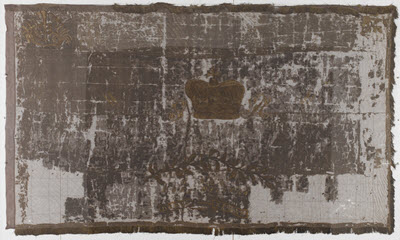
© Government of Canada, Canadian Conservation Institute. 100020-0001
Figure 2. The Regimental Colour of the 3rd Regiment of York Militia, before treatment.
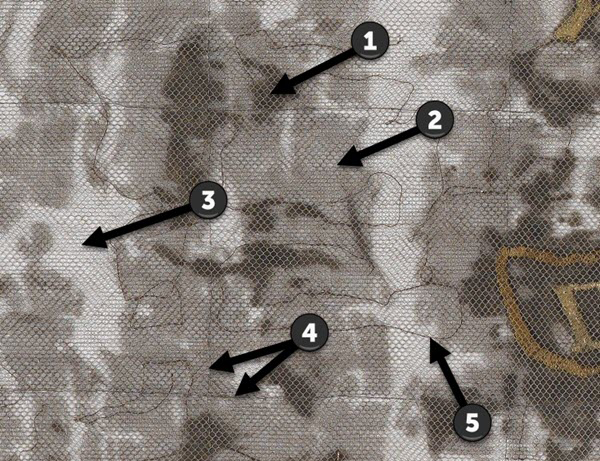
© Government of Canada, Canadian Conservation Institute. 100020-0003
Figure 3. Detail of flag before treatment showing fragments of flag (number 1) with sheer cotton fabric (number 2) encapsulated in two layers of cotton net (number 3). There was stitching through the cotton net (number 4) and inside the cotton net (number 5).
The flag arrived at CCI sandwiched between glazing and foam board, a simple form of pressure mount. The top edge of the flag was also attached to the foam board with double-sided tape. Both the net and the mount had helped preserve the flag, but neither was ideal. The net was quite coarse and had faded. The mount was chemically unstable and provided no cushioning for the thick embroidered areas, and its white colour emphasized all the losses from the flag. It was time to redo the net encapsulation and pressure mount using conservation-grade materials in a way that would also help the flag look like a flag once more.
Before we started any treatment, we needed to determine if we would still have a flag left after removing it from the mount and from the previous conservation fabrics and stitching. We also needed to work out methods for transferring these thousands of fragments onto a new padded support. We were very concerned about how much manipulation the silk fragments could withstand and what the flag would look like after we removed the net and sheer fabric, which camouflaged some of the flag’s losses.
Luckily, we were greatly aided by Conservation Scientist Greg Young and Photographer Carl Bigras. Using the before treatment photographs taken by Carl, Greg digitally separated the coarse cotton net and fragmented sheer fabric from the remains of the flag. This produced an image of just the remains of the flag. Greg also calculated that we had 49% of the flag left. To me, this image analysis work was one of the most innovative and useful aspects of the project. It helped everyone appreciate just how much, or little, of the flag remained to be treated.
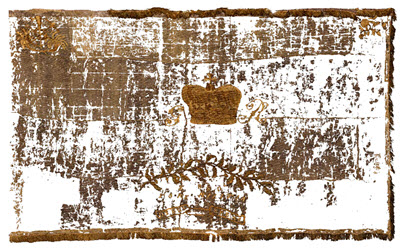
© Government of Canada, Canadian Conservation Institute.
Figure 4. Digital separation of flag showing that 49% of the flag remained.
AW: Once you learned that 49% of the flag remained, was it still possible to reconstruct the flag through conservation treatments?
JV: Yes, with help from a lot of colleagues at CCI. Before we could remove the old cotton net from both sides, we had to separate the double-sided tape from the foam backing board. Tape removal is a common problem in paper conservation, so conservators Sherry Guild and Greg Hill from the CCI paper laboratory guided us in this procedure.
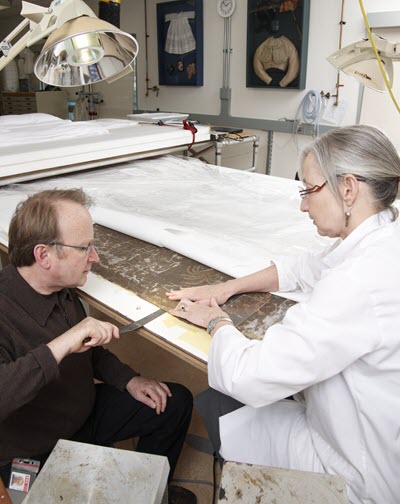
© Government of Canada, Canadian Conservation Institute. 100020-0024
Figure 5. CCI paper laboratory conservators Greg Hill (left) and Sherry Guild (right) releasing the double-sided tape from the foam board.
The next step was to snip through and remove the grid line stitches, then to cut away and remove the cotton net. We had to work very, very carefully because if the cotton net transferred movement to other areas, it would powder the silk flag fragments. To prevent this from happening, we immobilized the whole flag by covering it with small, lightweight pieces of see-through acrylic. The silk fragments tended to stick to the acrylic because of static electricity, so we wrapped the weights in a transparent nylon film to reduce the static electricity. The pieces of acrylic were immediately put back in place once the cotton net had been removed. We could safely uncover only a few inches of the flag at a time.
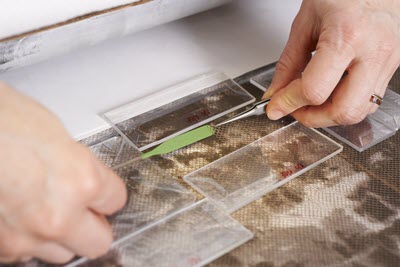
© Government of Canada, Canadian Conservation Institute. 100020-0085
Figure 6. Removing the cotton net from the front of the Regimental Colour.
It was a very meticulous task that involved small-scale, detailed work on a large-scale object. That was what a lot of textile conservation was: fine handiwork and very time-consuming labour, often done in uncomfortable positions. But you have to do it that way because you want to protect what is left.
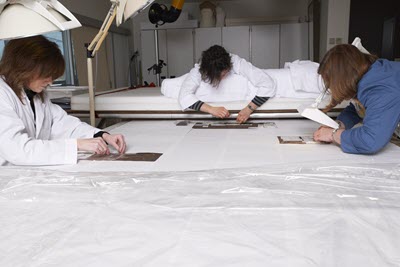
© Government of Canada, Canadian Conservation Institute. 100020-0081
Figure 7. Textile conservators Janet Wagner (left), Renée Dancause (centre) and Jan Vuori (right) removing the cotton net from the front of the Regimental Colour.
Once we had removed the net from the front, we covered it with a single piece of a very soft, fine nylon net that we had dyed to match the flag. Nylon net is very stretchy and once you put it down over thousands of loose fragments, you don’t have a second chance to take it up again, so it was very important to place it correctly over the flag in one go. Textile conservators Janet Wagner and Renée Dancause, with help from Preparator Bob McRae, devised a method to unroll the nylon net from a large tube suspended over the flag. The tube was connected to a wooden guide frame on the floor that allowed us to unroll the nylon net inch by inch over a narrow row of exposed fragments. It worked beautifully!
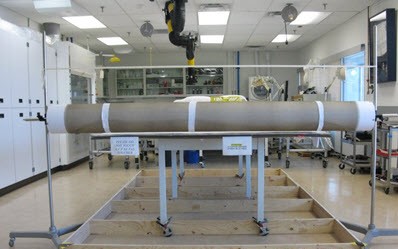
© Government of Canada, Canadian Conservation Institute. 100020-0235
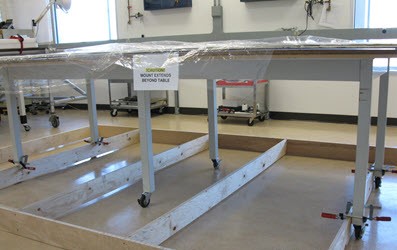
© Government of Canada, Canadian Conservation Institute. 100020-0236
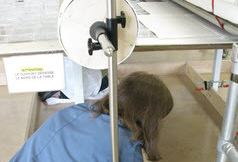
© Government of Canada, Canadian Conservation Institute. 100020-0237
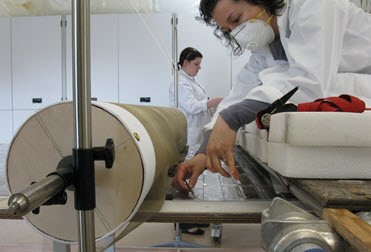
© Government of Canada, Canadian Conservation Institute. 100020-0238
© Government of Canada, Canadian Conservation Institute.
Figures 8a, 8b, 8c and 8d (top left, top right, bottom left and bottom right). Unrolling the nylon net over the textile using the guide frame.
The next hurdle was to turn the flag over so that we could work on the back. To make sure everything remained in place, we secured the nylon net covering the front to the old cotton net on the back using temporary stitches around the fragments. We then sandwiched the flag between two padded rigid supports that were securely tied together. Then we got lots of help from other people at CCI to turn the flag over. It was a hair-raising moment!
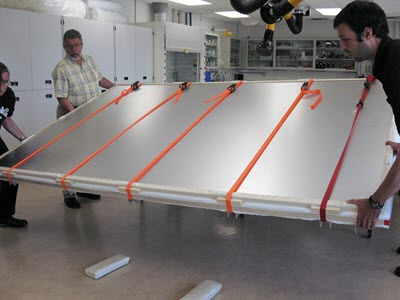
© Government of Canada, Canadian Conservation Institute. 125200-0006
Figure 9. Turning the flag over with help from Furniture Conservator James Hay (left), Archaeological Conservator Cliff Cook (centre) and Conservation Scientist Eric Hagan (right). Hagan was instrumental in selecting and installing the environmental monitoring devices inside the newly mounted Regimental Colour, as was Conservation Scientist Paul Marcon, who supervised all aspects of packing for transportation.
Once the flag was turned over, we repeated the same procedures on the other side. We removed the temporary stitches and the cotton net, put down a new layer of custom-dyed nylon net and stitched around the fragments to hold everything in place.
The final step was to pressure mount the flag using conservation grade materials and methods. Pressure mounting had not been traditionally used in the textile laboratory at CCI, so we consulted other conservators who have considerable experience with this technique. We were also greatly aided by CCI Conservation Scientidst Stefan Michalski who designed the mount and provided input on the materials.
The new mount was padded, but with recesses cut out of the padding to accommodate the thick embroidered decorations. Stitched onto the mount was a replica of the flag’s footprint made of custom-dyed cotton. This served to visually fill in the losses. All of these features had to match up perfectly when we lowered the mount onto the back of the flag and secured it for turning over. Another slightly hair-raising moment! But it all worked.
With the glazing installed, the Regimental Colour is both physically protected and can be appreciated as a flag again. But all the work we did is separable: you can remove the glazing from the front or the padded mount from the back, leaving the fragmented remains of the flag encased in protective netting.

© Government of Canada, Canadian Conservation Institute. 100020-0217
Figure 10. The Regimental Colour of the 3rd Regiment of York Militia, after treatment.
Treating the Colours of the 3rd York Militia Regiment certainly was a huge team effort and drew in a lot of people with different expertise. But that’s the way it works at CCI. It’s what makes CCI so special. We have conservators and conservation scientists, as well as photographers, preparators and interns. It all works because we draw on the synergy of a variety of talented people. That is why CCI is the place it is.
AW: Thank you for sharing Jan. Any final thoughts?
JV: I wish everyone at CCI the very best for the next 50 years. It really was a brilliant idea to create CCI in the first place, and I think there's always going to be a need for it, so I wish everyone there good luck!
To learn more about regimental Colours, consult chapter 5 of The Heritage Structure of the Canadian Forces.
To learn more about textile conservation at CCI, watch the videos “Treatment of the Marseille Petticoat” and “History of the Marseille Petticoat.”
To hear more personal reflections on the collaborative nature of the work at CCI, tune in to the podcast CCI and CHIN: In Our Words and listen to the episodes with Ela Keyserlingk, Judy Logan, Season Tse, Charlie Costain and Brian Arthur.
Bibliography
Dancause, R., and J. Vuori. “Lessons Learned: The Use of 20 Denier Nylon Net in the Treatment of Two Oversized Flags.” In S.C. Stevens, comp., Conserving Modernity: The Articulation of Innovation. 9th North American Textile Conservation Conference, San Francisco, California, November 12–15, 2013. San Francisco, CA: North American Textile Conservation Conference, 2013, pp. 86–101.
Vuori, J., R. Dancause and J. Wagner. “Conserving Canadian Identity: The Colours of the Third Regiment of York Militia.” REFLECTIONS on Conservation (2012), pp. 26–29.
Vuori, J., R. Dancause and S. Michalski. “Renewing the Past: Pressure Mounting a Large and Severely Fragmented Silk Flag.” In R. Hanson, ed., Journal of the American Institute for Conservation 56,1 (2017), pp. 59–74.
Vuori, J. “Overcominq a Conservation Challenge Through Collaboration: Treating a Suite of Upholstered Furniture.” REFLECTIONS on Conservation (2010), pp. 13–14.
© Government of Canada, Canadian Conservation Institute, 2023
Cat. No.: CH57-4/72-2023E-PDF
ISBN 978-0-660-49179-0